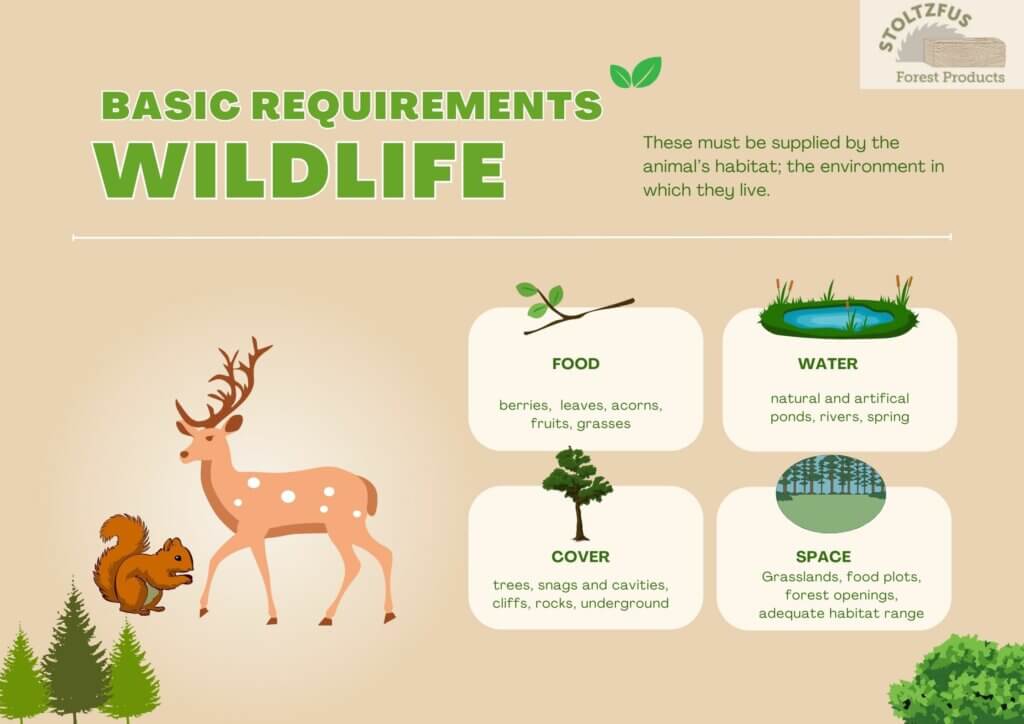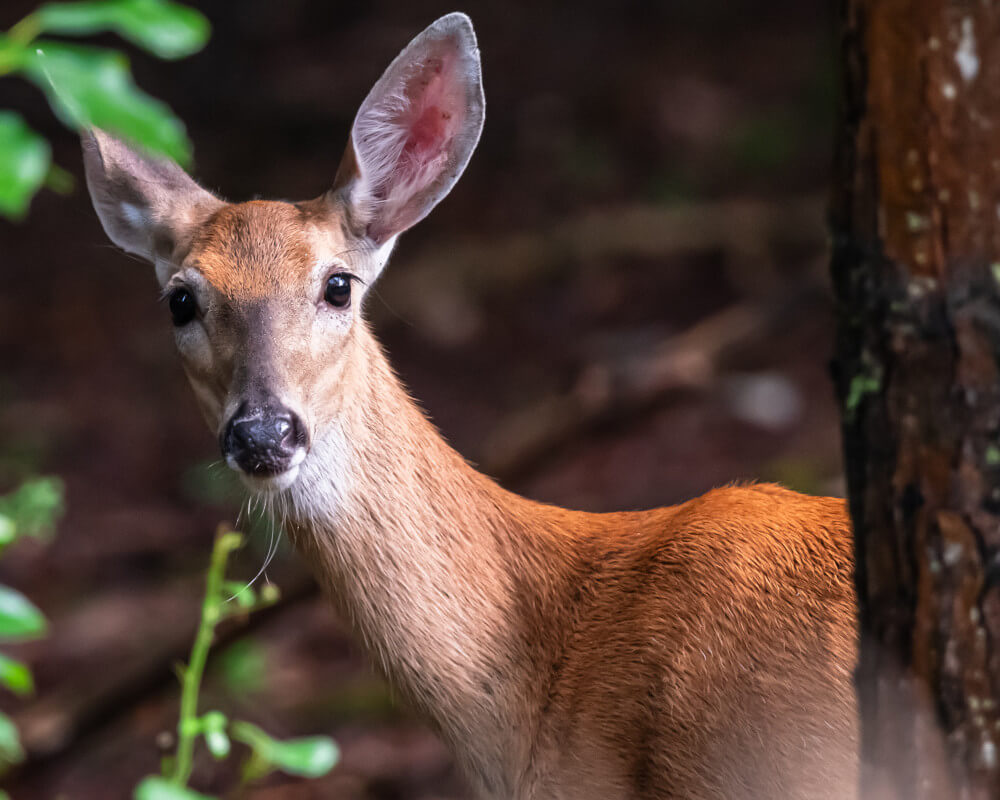Pennsylvania is home to many beautiful forests and woodlands that serve as a refuge to various species of wildlife. If you own some of this woodland, you might be wondering how you can help these animals and also take care of the trees. This article will give you some easy-to-follow tips on how to do just that. Whether you’re looking to attract more wildlife, grow more plants they love, or even create food plots, we’ve got you covered. Let’s dive in!
But before that, it is important to note that wildlife habitat management in fields for game and hunting as primary purposes is quite different from wildlife habitat management in woodlands. This guide is targeted to woodland owners, who through forest stewardship, aim at balancing timber production with conservation of wildlife habitats.
Why and How to Manage Wildlife in your Woodland?
As an increasing number of species in Pennsylvania are at risk from a myriad of problems from habitat loss to climate change, managing wildlife habitat has become an inherently noble endeavor. Moreover, such management practices have tangible economic benefits, ensuring the longevity and profitability of your forest.
A well-managed forest does more than just produce timber. It also serves as a sanctuary for wildlife, which is also an important renewable resource. While landowners today are more aware of the importance of wildlife in their woodlots, many still believe that an unmanaged woodland is best for wildlife. While this may be true for some time, it is usually not the case.
Essentially, wildlife has four basic requirements for their survival: food, water, cover and space as illustrated in the figure below:

A sound wildlife management section in your forest management plan should account these four factors to manage wildlife effectively. The following sections will provide insight on the things to consider as a landowner.
Wildlife Friendly Timber Management Practices
A well-cared-for forest serves more than just the purpose of providing timber; it becomes a vital habitat and refuge for various wildlife species. To achieve this balance, here are some practices to delve into:
1. Maintaining the Vertical and Structural Diversity:
A forest with high vertical diversity is one which has a well-developed overstory, understory, shrubs and herbaceous layers. These layers, from the ground to the tree canopy, allow many plants and animals to live together. For instance, in mature forests, ovenbirds stay close to the ground, tanagers like the treetops, and chickadees are somewhere in between. A mix of tree ages makes this layering more suitable for species to coexist, compared to a forest with a uniform height. However, a high deer population can disturb this balance by eating the understory.
Structural diversity means having a mix of living and nonliving things in different shapes and sizes in the forest. Dead trees, a variety of plants, and the layers mentioned earlier all add to this mix. Features like fallen logs are important because they offer hiding spots for animals and attract insects, adding to the overall health and variety of forest life.
2. During Timber Harvesting
On forest lands primarily used for timber production, there are timber management practices used during harvesting that benefit the wildlife. One such example is retaining deadwood or logs in the stand as well as leaving behind live trees that have cavities in order to provide shelter and nest sites for the wildlife and birds. Moreover, leaving behind stumps and slash will also provide cover for many species, specially small mammals in winter. Moreover, timber harvesting should be planned in a way that creates suitable feeding zones and resting places for wildlife.
3. Buffer Zones and Special Habitat:
Your silvicultural plan should consider areas within your woodlot which have special significance as wildlife habitat. For instance, strips of vegetation along the waterways should be retained. These areas, known as riparian buffers, are crucial habitats and travel corridors for many species. Another example of special habitat to consider excluding silvicultural operations from include wetlands, which are the most productive and rarest habit type in Pennsylvania.
Plants Essential to Pennsylvania Wildlife
In Pennsylvania, a diverse range of plants plays a vital role in supporting the state’s rich wildlife population. These plants provide basic requirements of wildlife habitats, including food, cover, and even water sources.
- Blackberry bushes offer sustenance to animals such as brown thrashers, chipmunks, and white-tailed deer, especially during spring and fall.
- Cherries attract black bears, raccoons, and red squirrels.
- Grapes, ragweed, and dogwood also contribute to the dietary needs of numerous wildlife species like songbirds and mammals.
- Oak trees are very important. as they provide sustenance to black bears, blue jays, and white-tailed deer, particularly in spring and fall.
- Additionally, beech trees are vital for chipmunks, porcupines, and wild turkeys, offering food across multiple seasons.
- Furthermore, poison ivy and sumac become essential food sources during fall and winter for species like black-capped chickadees, gray catbirds, and raccoons.
These plant species, along with many others not mentioned, collectively form the foundation of Pennsylvania’s wildlife habitats, ensuring that various animals have access to nourishment year-round. A sound wildlife management plan should consider the importance of these plants and also the local conditions of your forest for effective habitat creation and management.
Why Dead Trees Are Important To Wildlife?
There are very few dead trees in the forests of Pennsylvania because of historical management and also because landowners don’t find it appealing to have dead tress on their lands and woodlots. However, as habitat for certain wildlife species, dead trees are higher in demand than live trees. Dead trees, whether standing (snags) or on the ground (logs), play an essential role in woodland ecosystems. Here’s why:
- Homes for Wildlife: Snags provide cavities for various birds and mammals to nest and roost. Species like bluebirds, wood ducks, woodpeckers, owls, and bats greatly benefit from these structures.
- Nutrient Recycling: As dead trees decompose, they release nutrients back into the soil. This promotes the growth of new plants, which is beneficial for wildlife as a food source.
- Food Source: Insects thrive on decaying wood, attracting predators like birds and amphibians.
It has been estimated that dead trees and trees that contain decaying wood provide important habitat for about 25 percent of the forest wildlife species in the northeastern United States. Allowing dead trees to remain in your woodland can significantly enhance its biodiversity by becoming a wildlife magnet.
Incorporating Food Plots into Your Woodland
Food plots are one way where landowners can actively intervene to provide suitable habitat for wildlife. Food plots are managed patches of land which are planted with specific plants to provide additional sources of nutrition or food for wildlife. In the context of Pennsylvania, food plots are mainly used for deer. Food plots are crucial during seasons when the herbaceous food is very low. Food plots are also an efficient means of attracting game.
Food plots can be incorporated into your woodland in the form of forest openings or herbaceous openings. A good wildlife management practice is to maintain 3-8% of your wooded area in openings. The number and size of these plots also depends on the land surrounding these plots. You might need smaller plots or fewer plots if you are near farmland as compared to if you have a continuous forest. Trails, right of ways and log landings can also provide the same function as food plots with a little management like seeding with grasses and legumes, tilling, mowing and fertilizing.
Wildlife Habitat Management Programs For Landowners
Several organizations like the Pennsylvania Game Commission in Pennsylvania offer numerous programs to assist landowners in managing their forests for wildlife. Here are some worth exploring:
- Private Landowner Assistance Program – This is a special program from the Pennsylvania Game Commission where a team of biologists assist you in making your property more wildlife friendly, mainly for the species of greatest conservation needs. They make detailed plans for interested landowners and are grouped in all of the six geographical regions of the state.
As an interested landowner, you start by contacting the regional office for your county after which you will be asked to fill an objective survey which will be followed by a field visit by the biologist and a plan will be made based on the findings.
This is also a program by the game commission where as a landowner you enter into a partnership agreement with the commission. As a landowner, you provide reasonable hunting and trapping access, with the flexibility to set some property restrictions, and in return, you will benefit from incentives such as discounted licenses, free seedlings, habitat management assistance, and law enforcement patrols.
If you have erodible and marginal lands near streams, through this program, you can enroll it into conservation cover and in return, you will be offered financial benefits and support from multiple partners, to enhance water quality, soil retention, wildlife habitats, and increase profitability on marginal farmlands.
Aside from these, there are many other programs which cover specific habitat types or specific species that landowners can benefit from:
- Partners for Fish and Wildlife Program in Pennsylvania
- Barn Owl Conservation Initiative
- Deer Management Assistance Program – DMAP
- Agricultural Deer Control (AG Tag) Program
- The Pennsylvania Ecological Services Field Office
- Pennsylvania Forest Stewards
Contributed by Sandesh KC
